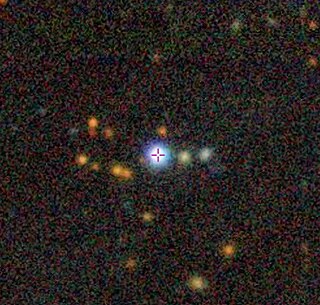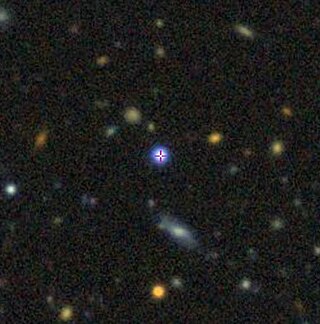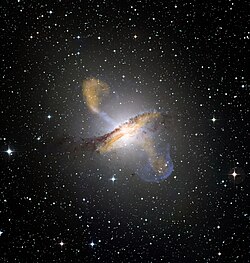
A quasar is an extremely luminous active galactic nucleus (AGN). It is sometimes known as a quasi-stellar object, abbreviated QSO. The emission from an AGN is powered by a supermassive black hole with a mass ranging from millions to tens of billions of solar masses, surrounded by a gaseous accretion disc. Gas in the disc falling towards the black hole heats up and releases energy in the form of electromagnetic radiation. The radiant energy of quasars is enormous; the most powerful quasars have luminosities thousands of times greater than that of a galaxy such as the Milky Way. Quasars are usually categorized as a subclass of the more general category of AGN. The redshifts of quasars are of cosmological origin.
An active galactic nucleus (AGN) is a compact region at the center of a galaxy that emits a significant amount of energy across the electromagnetic spectrum, with characteristics indicating that this luminosity is not produced by the stars. Such excess, non-stellar emissions have been observed in the radio, microwave, infrared, optical, ultra-violet, X-ray and gamma ray wavebands. A galaxy hosting an AGN is called an active galaxy. The non-stellar radiation from an AGN is theorized to result from the accretion of matter by a supermassive black hole at the center of its host galaxy.

3C 273 is a quasar located at the center of a giant elliptical galaxy in the constellation of Virgo. It was the first quasar ever to be identified and is the visually brightest quasar in the sky as seen from Earth, with an apparent visual magnitude of 12.9. The derived distance to this object is 749 megaparsecs. The mass of its central supermassive black hole is approximately 886 million times the mass of the Sun.

Seyfert galaxies are one of the two largest groups of active galaxies, along with quasar host galaxies. They have quasar-like nuclei with very high surface brightnesses whose spectra reveal strong, high-ionisation emission lines, but unlike quasars, their host galaxies are clearly detectable.

A blazar is an active galactic nucleus (AGN) with a relativistic jet directed very nearly towards an observer. Relativistic beaming of electromagnetic radiation from the jet makes blazars appear much brighter than they would be if the jet were pointed in a direction away from Earth. Blazars are powerful sources of emission across the electromagnetic spectrum and are observed to be sources of high-energy gamma ray photons. Blazars are highly variable sources, often undergoing rapid and dramatic fluctuations in brightness on short timescales. Some blazar jets appear to exhibit superluminal motion, another consequence of material in the jet traveling toward the observer at nearly the speed of light.

BL Lacertae or BL Lac is a highly variable, extragalactic active galactic nucleus. It was first discovered by Cuno Hoffmeister in 1929, but was originally thought to be an irregular variable star in the Milky Way galaxy and so was given a variable star designation. In 1968, the "star" was identified by John Schmitt at the David Dunlap Observatory as a bright, variable radio source. A faint trace of a host galaxy was also found. In 1974, Oke and Gunn measured the redshift of BL Lacertae as z = 0.07, corresponding to a recession velocity of 21,000 km/s with respect to the Milky Way. The redshift figure implies that the object lies at a distance of 900 million light years.

An optically violent variable quasar is a type of highly variable quasar. It is a subtype of blazar that consists of a few rare, bright radio galaxies, whose visible light output can change by 50% in a day. OVV quasars have essentially become unified with highly polarized quasars (HPQ), core-dominated quasars (CDQ), and flat-spectrum radio quasars (FSRQ). Different terms are used but the term FSRQ is gaining popularity effectively making the other terms archaic.

A low-ionization nuclear emission-line region (LINER) is a type of galactic nucleus that is defined by its spectral line emission. The spectra typically include line emission from weakly ionized or neutral atoms, such as O, O+, N+, and S+. Conversely, the spectral line emission from strongly ionized atoms, such as O++, Ne++, and He+, is relatively weak. The class of galactic nuclei was first identified by Timothy Heckman in the third of a series of papers on the spectra of galactic nuclei that were published in 1980.
The Whole Earth Blazar Telescope (WEBT) is an international consortium of astronomers created in 1997, with the aim to study a particular category of Active Galactic Nuclei (AGN) called blazars, which are characterized by strong and fast brightness variability, on time scales down to hours or less.

S5 0014+81 is a distant, compact, hyperluminous, broad-absorption-line quasar, or blazar, located near the high declination region of the constellation Cepheus, near the North Equatorial Pole.
The Parkes Catalogue of Radio Sources, also known as the Parkes Southern Radio Source Catalog, consists of 8264 astronomical radio sources, mostly south of declination +27. The catalogue was mostly compiled by John Bolton and his colleagues for 20 years. Both the Molonglo 408-MHz survey and the 80-MHz Culgoora measurements of Slee et al have contributed to the usefulness of the catalogue. For now, the catalogue only contains sources originally found in the Parkes 2700-MHz survey. The catalogue contains radio sources that have a frequency range of 80 - 22,000 MHz.

AP Librae is a BL Lacertae object located at a distance of 700 million light years in the southern constellation of Libra. In the visual band it is one of the most active blazars known. AP Lib is surrounded by an extended source with a spectrum characteristic of a red-shifted giant elliptical galaxy. The derived visual magnitude of this region is 15.0, and it follows a radially decreasing brightness that is characteristic of an elliptical. Seven fainter galaxies are visible within an angular radius of 9′, suggesting it is the brightest member of a galactic cluster.

PKS 2131-021 is quasar and a BL Lacerate object, producing an astrophysical jet. lt is located in the constellation Aquarius and classified as a blazar, a type of active galactic nucleus whose relativistic jet points in the direction towards Earth.

PKS 0537-286, also known as QSO B0537-286, is a quasar located in the constellation Columba. With a redshift of 3.104, the object is located 11.4 billion light years away and belongs to the flat spectrum radio quasar blazar subclass (FSQR). It is one of the most luminous known high-redshift quasars.

PKS 2126-158, also known as PKS 2126-15, is a quasar located in Capricornus. It has a redshift of 3.268000, which corresponds to the distance of 11.5 billion light years. It is classified as a gigahertz peaked-spectrum quasar (GPS) with a flat-spectrum radio source and a blazar, a type of active galaxy shooting an astrophysical jet towards Earth.

PKS 0226-559 known as PMN J0228-5546 is a quasar located in the constellation Horologium. At the redshift of 2.464, the object is roughly 10.6 billion light-years from Earth.

PKS 1144-379 also known as PKS B1144-379, is a quasar located in the constellation of Centaurus. At the redshift of 1.048, the object is located nearly 8 billion light-years from Earth.

PKS 1402-012, also known as UM 632, is a quasar located in the constellation of Virgo. With a redshift of 2.51, the object is located 10.7 billion light-years from Earth.

PKS 1402+044 is a quasar located in the constellation of Virgo. It has a redshift of 3.207, estimating the object to be located 11.3 billion light-years away from Earth.

PKS 0805-07 also known as PMN J0808-0751 and 4FGL J0808.2-0751, is a quasar located in the constellation of Monoceros. With a redshift of 1.83, light has taken at least 10 billion light-years to reach Earth.






















